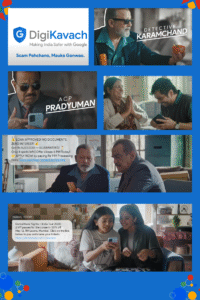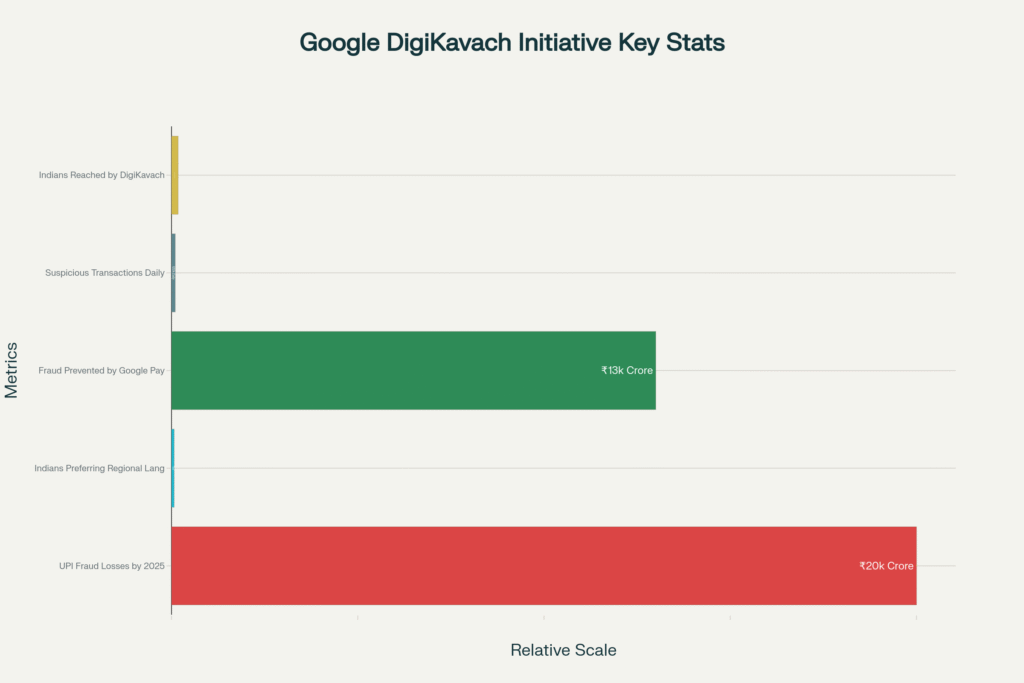How Google India’s fraud prevention masterclass offers digital marketing professionals essential lessons in culturally intelligent advertising

When Google India faced the challenge of making digital fraud awareness compelling, their Google DigiKavach campaign analysis reveals a sophisticated solution that transformed cybersecurity education from tedious corporate messaging into genuinely watchable entertainment.
The Google DigiKavach campaign recruited two of India’s most beloved television detectives—Pankaj Kapur and Shivaji Satam—to investigate thoroughly modern crimes requiring not fingerprints but analytical thinking and digital awareness. This DigiKavach campaign effectiveness study demonstrates how the strategic minds at Ogilvy Mumbai and Offroad Films created something far more sophisticated than typical public service advertising.
Understanding Google DigiKavach Campaign Analysis: The Cultural Intelligence Factor
The Google DigiKavach campaign analysis reveals that effectiveness lies not in production values—though they’re excellent—but in understanding how trust functions within Indian society.

Kapur and Satam aren’t merely celebrity endorsers; they’re cultural institutions representing analytical thinking and protective authority.[1][2]
When Kapur’s character observes, “Detective, celebrate? I think something’s wrong,” while examining a suspicious job offer, the DigiKavach campaign effectiveness becomes clear—audiences witness exactly the type of measured analysis Google wants them to apply to digital communications.[3]
This Google fraud prevention campaign approach contrasts sharply with contemporary digital marketing that prioritises viral reach over genuine connection. Unlike campaigns that feel focus-grouped into bland universality, this Google DigiKavach campaign analysis shows what happens when brands understand local context rather than simply translating global messaging.
Consider how this differs from approaches in our fashion advertising analysis, where brands often use aspirational imagery disconnected from daily reality. The Google DigiKavach campaign embeds crucial information within culturally resonant narratives—family celebrations with traditional sweets, maternal blessings, and collective joy that makes subsequent revelations more impactful.

Google DigiKavach Campaign Analysis: The Detective Educational Framework
What distinguishes this Google fraud prevention campaign from typical corporate digital safety messaging is its systematic educational approach. Rather than lecturing about abstract security principles, it provides transferable analytical frameworks that viewers can apply to suspicious communications.
“Instead of paying you, they’re asking for money. The link is unknown, and no job interview?” This analysis avoids technical jargon, applying common sense instead. The DigiKavach campaign effectiveness lies in presenting detective work as learnable skill rather than specialised knowledge, transforming potential victims into active participants.[3]
The Google DigiKavach campaign analysis becomes apparent across multiple scenarios. Concert ticket offers reveal how even educated, tech-savvy individuals can suspend critical thinking when confronted with appealing deals. Meanwhile, “unbelievable discount” scenarios demonstrate that all users remain vulnerable to obviously fraudulent offers.[4][3]
For digital marketers, this represents excellent contextual advertising—content feeling native to its cultural environment while serving legitimate educational purposes. Research shows contextual advertising achieves 25% higher engagement rates than traditional mass advertising, with the global market reaching USD 608.3 billion by 2032.[5][6]
Why This Google DigiKavach Campaign Matters: The Numbers
The Google DigiKavach campaign addresses genuine crisis conditions within India’s digital ecosystem. UPI fraud cases reach alarming levels with projected losses of ₹20,000 crore by 2025. This represents urgent social problem-solving rather than simple brand building.[7][8]

This Google fraud prevention campaign arrives precisely as India’s digital transformation accelerates. Current data shows 70% of Indian internet users prefer regional languages over English for digital communication, presenting both opportunities and challenges as scammers increasingly target first-time internet users less familiar with digital safety protocols.[9]
Key DigiKavach Campaign Performance Metrics
The DigiKavach campaign effectiveness can be measured through impressive statistics:
- 177 million Indians reached through fraud prevention campaigns
- ₹13,000 crore in fraudulent transactions prevented by Google Pay
- 100,000 suspicious transactions declined daily
- ₹20,000 crore projected fraud losses without intervention
These aren’t merely statistics—they represent fundamental shifts in how technology companies approach social responsibilities.[4]
Google DigiKavach Campaign Analysis: What Could Have Been Stronger

Despite its considerable strengths, this Google DigiKavach campaign analysis reveals several missed opportunities that could have further improved its impact.
The Linguistic Limitation Challenge
The campaign’s Hindi-centric approach, whilst culturally appropriate for much of India, represents a strategic blind spot. With 70% of users preferring regional languages[9], a more comprehensive approach would have included vernacular adaptations addressing region-specific fraud patterns. Tamil-speaking audiences in Chennai face different scam types than Bengali speakers in Kolkata—yet the campaign treats digital fraud as linguistically uniform.
A more sophisticated approach would have recognised that fraud tactics vary significantly across India’s linguistic regions. Investment scams targeting Gujarati business communities differ markedly from job offer frauds affecting Hindi-speaking youth in tier-2 cities. The campaign’s effectiveness could have increased substantially with targeted regional messaging addressing these variations.
The Demographic Gaps in Casting
While Kapur and Satam command immense respect, their appeal skews towards older demographics who grew up watching their shows. Younger audiences—primary targets for modern digital scams—might connect more readily with contemporary influencers or actors from recent web series.
The Google fraud prevention campaign could have benefited from multi-generational casting that includes younger, digitally native personalities alongside the veteran detectives. This approach would maintain cultural credibility whilst expanding reach to demographics most vulnerable to evolving fraud techniques.
The Missing Interactive Elements
The campaign’s one-way educational approach, whilst effective, missed opportunities for active audience participation. Interactive elements—such as embedded quizzes, fraud scenario simulators, or real-time reporting mechanisms—could have transformed passive viewers into active participants in fraud prevention.
A more digitally integrated approach might have included QR codes linking to fraud verification tools or chatbot interfaces allowing users to report suspicious messages immediately after viewing the campaign. This would have created measurable engagement beyond traditional reach metrics.
The Behavioural Science Oversight
The DigiKavach campaign effectiveness relies heavily on rational analysis—”look for these warning signs, apply logical thinking.” However, behavioural psychology research suggests that fraud victims often recognise warning signs but ignore them due to emotional manipulation or time pressure.
The campaign could have incorporated cognitive bias training—teaching audiences to recognise when they’re being emotionally manipulated rather than simply providing logical frameworks. Scenarios demonstrating how urgency tactics and social proof manipulation override rational thinking would have provided more robust defence mechanisms.
Google DigiKavach Campaign Analysis: Professional Marketing Insights

From a digital marketing perspective, this Google DigiKavach campaign analysis offers valuable insights whilst revealing strategic gaps:
Authenticity Over Aspiration
Unlike Maybelline’s Mumbai approach that felt disconnected from Indian realities, the DigiKavach campaign effectiveness demonstrates authentic cultural embedding. However, the campaign’s urban-centric scenarios may not resonate with rural audiences facing different fraud challenges—agricultural loan scams, government benefit frauds, or SHG-related deceptions.
Educational Value Creates Competitive Advantage
The Google fraud prevention campaign succeeds by providing genuine audience value—transferable analytical skills extending beyond immediate messaging objectives. However, the lack of follow-up educational content represents a missed opportunity for sustained engagement and deeper learning.[11]
Strategic Trust Architecture with Room for Enhancement
Actor selection demonstrated strategic trust-building, but the campaign could have benefited from diverse authority figures—police officials, bank managers, or community leaders—to provide additional credibility layers. Celebrity endorsement effectiveness in India shows that multiple authority sources often prove more convincing than single-celebrity messaging.[12]
Multi-Scenario Storytelling with Execution Gaps
Rather than single narratives, the campaign addresses different vulnerability points—job seekers, entertainment fans, bargain hunters. However, the scenarios remain relatively surface-level without exploring psychological manipulation techniques that make these scams effective. Deeper exploration of emotional triggers would have provided more comprehensive protection.
Google DigiKavach Campaign Analysis: Measurement and Enhancement Opportunities
Measuring fraud prevention campaigns presents unique challenges, but this Google DigiKavach campaign analysis suggests several enhancement possibilities:
The DigiKavach campaign’s 177 million user reach provides quantitative indicators, but qualitative measurement remains limited. Post-campaign surveys, behavioural tracking studies, or fraud reporting rate analysis could have provided deeper effectiveness insights.[4]
More sophisticated measurement might have included:
- Retention testing: Do viewers remember key warning signs weeks after exposure?
- Application assessment: Can audiences correctly identify new fraud scenarios not featured in campaigns?
- Behavioural change tracking: Do users actually report suspicious messages more frequently post-campaign?
Google DigiKavach Campaign Analysis: Technology Integration Missed Opportunities
This Google DigiKavach campaign analysis demonstrates that while AI-powered personalisation and programmatic advertising transform the industry, the campaign’s technology integration remained surprisingly limited.[14]
Google’s broader fraud prevention infrastructure—AI-powered detection systems identifying suspicious patterns—could have been better integrated with the public-facing campaign. Real-time fraud alerts, personalised risk assessments, or dynamic content adaptation based on user vulnerability profiles would have created more comprehensive protection.[15][4]
The disconnect between Google’s sophisticated backend technology and the campaign’s relatively simple messaging represents a missed opportunity for demonstrating integrated digital safety solutions.
Industry Evolution Through Google DigiKavach Campaign Analysis
The DigiKavach campaign effectiveness represents Indian advertising evolution beyond product promotion toward genuine public service, but with notable limitations in execution sophistication.[10]
With digital advertising spending in India projected to reach ₹52,992 crore in 2025, campaigns successfully bridging cultural authenticity with digital-first messaging become valuable. However, this Google DigiKavach campaign analysis suggests that technical innovation and cultural intelligence can be better integrated for superior outcomes.[18]
A More Strategic Approach: What I Would Have Done Differently
Having analysed the campaign’s strengths and limitations, a more comprehensive Google fraud prevention campaign might have included:
Multi-Layered Authority Framework
Rather than relying solely on television detectives, I would have created a diverse authority ecosystem including cybercrime police officers, bank security experts, and reformed fraudsters providing insider perspectives on manipulation techniques.
Regional Customisation Strategy
Instead of Hindi-centric messaging, I would have developed region-specific campaigns addressing local fraud patterns, using appropriate regional personalities and cultural references whilst maintaining consistent core messaging.
Interactive Digital Integration
The campaign could have benefited from companion digital experiences—mobile apps allowing users to verify suspicious messages, interactive fraud scenario training, and community reporting mechanisms that transform passive viewers into active fraud prevention participants.
Psychological Depth Enhancement
Beyond logical analysis, I would have incorporated emotional manipulation awareness training—teaching audiences to recognise when scammers exploit psychological biases like urgency, authority, and social proof to override rational thinking.
Longitudinal Engagement Design
Rather than discrete campaign bursts, a sustained educational programme with regular content updates, new scenario introductions, and progressive skill-building would have maintained audience engagement whilst adapting to evolving fraud techniques.
Global Template: Scaling Cultural Intelligence with Enhanced Execution
Google’s DigiKavach approach provides compelling templates for global brands, but with execution refinements that could significantly enhance effectiveness.
The collaboration between technology, creativity, and cultural insight suggests possibilities for more sophisticated integration of AI-driven personalisation with culturally intelligent messaging. Future campaigns might leverage machine learning to identify individual vulnerability patterns whilst delivering culturally resonant educational content.
Practical Applications from Google DigiKavach Campaign Analysis
For marketing professionals seeking to apply insights from this Google DigiKavach campaign analysis:
Audit Your Trust Architecture Beyond Celebrity Appeal
Examine whether campaigns rely on diverse credibility sources rather than single celebrity endorsement. Effective fraud prevention requires multiple authority validation rather than individual personality dependence.
Develop Regional Intelligence Frameworks
Consider how messaging can be adapted for specific regional vulnerabilities and cultural contexts rather than assuming universal applicability.
Integrate Interactive Digital Elements
Evaluate opportunities for audience participation beyond passive consumption—tools, assessments, and reporting mechanisms that transform viewers into active participants.
Address Emotional Manipulation Patterns
Develop content that acknowledges psychological vulnerability alongside logical analysis—teaching audiences to recognise when they’re being emotionally manipulated.
Design for Sustained Engagement
Consider longitudinal educational approaches rather than discrete campaign bursts, allowing for progressive skill development and adaptation to evolving threats.
Google DigiKavach Campaign Analysis: The Balanced Achievement
“Now what’s there to celebrate?! We’ve caught a scam, doesn’t that call for a celebration?” This detective observation captures the DigiKavach campaign’s essential achievement whilst highlighting its limitations—transforming potential vulnerability into intellectual satisfaction through psychological reframing that could have been even more sophisticated.[3]
This Google DigiKavach campaign analysis reveals how the campaign succeeds by treating digital fraud prevention as storytelling challenge rather than compliance requirement. However, the execution leaves room for enhancement in regional adaptation, psychological depth, and technology integration that could have amplified effectiveness significantly.
For marketing professionals navigating increasingly complex digital terrain, the Google fraud prevention campaign offers valuable templates whilst demonstrating that even well-executed campaigns benefit from critical analysis and strategic enhancement. It proves that effective communication requires strategic thinking and cultural insight, but also reveals opportunities for more sophisticated integration of behavioural psychology and technology capabilities.
The true achievement lies in demonstrating that purpose-driven marketing can create positive associations extending beyond immediate messaging objectives. However, this DigiKavach campaign effectiveness analysis suggests that even greater impact becomes possible when cultural intelligence combines with deeper psychological understanding and enhanced technology integration.
The collaboration between technology, creativity, and cultural insight that the Google DigiKavach campaign represents suggests possibilities for corporate communication serving society more comprehensively. In India’s rapidly evolving digital landscape, that provides genuine cause for optimism—whilst acknowledging substantial room for strategic enhancement and execution sophistication.
Sources:
[1] https://timesofindia.indiatimes.com/tv/news/hindi/cid-2-shivaji-satam-sparks-excitement-in-fans-with-his-smashing-entry-says-6-saal-baad-lauta-hu-lekin-akad-toh-vohi-hai/articleshow/116094340.cms
[2] https://www.hindustantimes.com/tv/cid-continues-to-rule/story-myPpNunKoTXwfFoexg3bmN.html
[3] https://www.youtube.com/watch?v=rOHQbeY-aNs
[4] https://www.youtube.com/watch?v=NgGURtZuz0c
[5] https://www.grandviewresearch.com/industry-analysis/contextual-advertising-market-report
[6] https://www.gminsights.com/industry-analysis/contextual-advertising-market
[7] https://bostoninstituteofanalytics.org/blog/google-indias-₹20000-crore-cybercrime-prevention-drive-how-ai-is-protecting-digital-payments/
[8] https://timesofindia.indiatimes.com/gadgets-news/google-for-india-digikavach-launched-to-keep-internet-users-safe-online/articleshow/104551642.cms
[9] https://www.thinkwithgoogle.com/intl/en-apac/consumer-insights/consumer-trends/speak-my-language-how-local-language-messaging-can-help-brands-offer-richer-experiences/
[10] https://www.campaignindia.in/article/cultural-tadka-drives-indias-most-effective-ads-in-2025/503556
[11] https://www.socialsamosa.com/report/contextual-marketing-campaign-revenue-report-8992515
[12] https://reputationtoday.in/star-power-and-storytelling-navigating-the-celebrity-endorsement-game-in-india/
[13] https://www.newmediaandmarketing.com/measuring-online-ads-metrics-analytics-and-fraud-prevention/
[14] https://www.adgully.com/contextual-advertising-ai-to-reshape-ad-landscape-in-2025-vishal-singh-154671.html
[15] https://mediaofficers.com/what-is-digikavach-by-google/
[16] https://www.sellerassistant.app/blog/top-5-amazon-advertising-strategies-to-utilize-in-2024
[17] https://www.youtube.com/watch?v=dDG2V3EtCbk
[18] https://bizbuddy.co.in/indias-booming-digital-advertising-landscape-in-2025/
[19] https://iide.co/case-studies/marketing-strategy-of-amazon/
